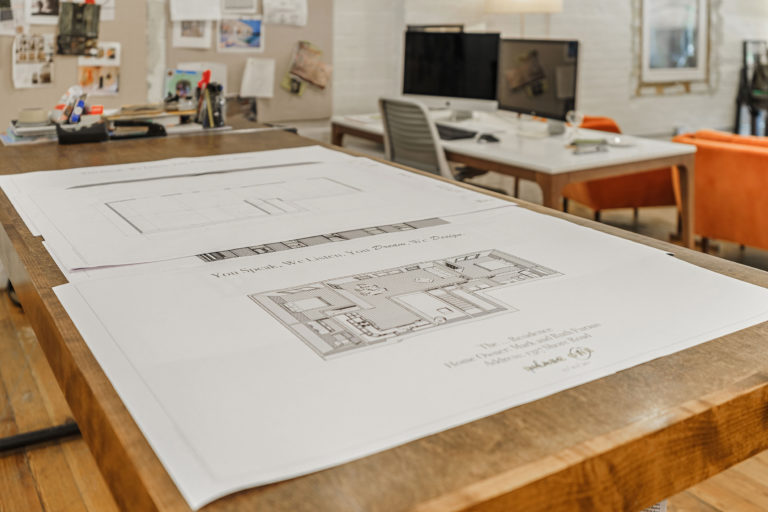Don’t you just hate being stuck in a poorly designed space? The lighting isn’t right. The color is depressing. The place feels too sterile. Or maybe there is way too much going on with a jumble of unrelated items making relaxation or focus quite impossible.
Whether you are creating a beautifully renovated room, considering home addition plans, or designing and building a new custom house, you need just the right design ideas to end up with the home of your dreams. A place you actually love living in.
The 7 basic elements of interior design include the important stuff—light, line, space, form, color, pattern, and texture. When handled correctly, these components bring the magic.
01. Light
The right lighting plays up all the other features in the room, allows you to see clearly, and directs the eye to certain focal points like the layers of lighting do in the kitchen above.
Natural lighting/daylight
from the windows brightens the mood and warms the entire space. Then artificial lighting adds an extra dimension.
Artificial lighting
Electric lights complete the job that natural lighting can’t accomplish on its own in a room. Inadequate lighting produces dreariness. Working or walking safely could even be a challenge. It’s important to have the right balance of lighting for maximum enjoyment and function of the space.
Ambient lighting
The recessed lights in the ceiling provide general light for the room.
Task lighting
The chandeliers provide bright light for the workspace on the kitchen island. No one wants to cut up celery in the dark, after all.
Mood lighting
The glowing under-counter lighting provides an accent to direct the eye to the pattern on the backsplash. Then wall sconces provide an atmosphere of ambiance and romance.
02. Line
You just can’t have a room without lines. Horizontal, vertical, and dynamic. They’ll be there, guiding your eye. The question is, How do you want them to work for you?
Vertical lines
Lines that run up and down in this kitchen like doorways, the refrigerator, walls, and windows provide an illusion of height and freedom. But if there are too many vertical lines, people may feel uncomfortable.
Horizontal lines
Lines that run along the surface of this counter, the island, or ceiling beams of this room evoke a sense of stability, formality, and security. These lines can make the room seem wider. However, if horizontal lines are overemphasized, the space can feel a bit boring.
Dynamic lines
Dynamic lines convey a sense of motion like diagonals, zigzags, waves, or curves. These lines build excitement and interest like the curved neck of the kitchen sink faucet. Moderation is key because too many dynamic lines can feel too busy.
03. Space
Interior spaces involve set dimensions and wise space planning. For a space you adore, go for a delicate balance of negative and positive space as shown in this room, above. Balance is key when using the elements of interior design.
You don’t want to feel crowded and claustrophobic with furniture jam-packed everywhere and barely any room to walk. But you also don’t want to feel like you live in a cavernous, sterile art museum.
Negative Space
Open-concept home plans are so popular because even the overhead empty space creates an illusion of a bigger home.
If there isn’t enough negative space, you may feel overwhelmed by all the stuff, longing for more room to breathe.
Positive Space
The areas that are filled with furniture, artwork, walls, counters, and the massive island are positive space. The eye focuses primarily on these objects.
04. Form
Every solid three-dimensional object has a shape. It’s what makes these padded, rounded benches different from a built-in kitchen nook bench.
The form, scale, and contours of each object contributes to the sense of style of the room.
When there is a sense of cohesion in room design, it’s pleasing to the eye. Cohesion helps your brain make sense of a space and feel at ease. Where there is no cohesion of form, you may feel uneasy. When used wisely, the elements of interior design allow people to feel at home, welcome, and happy to be in a space.
05. Color
Color provides energy and attitude, setting the emotional thermostat like this red barn door. Some colors bring about positive emotions. Other colors sap all the life and energy out of you and make you feel like hiding under a blanket for the rest of the day.
The psychology of color allows you to set the particular mood you desire for a room through the color palette you choose. Red invokes a sense of vibrancy and hunger. Greens and blues communicate peacefulness. Yellow conjures feelings of cheer and happiness.
The right color can make thousands of dollars worth of difference in people’s perception of the value of a space when you sell your home.
06. Pattern
Patterns breathe life into a room. Many types of patterns grace our spaces today—geometric shapes, stripes, animal prints, abstract, organic, motifs (like space, faces, woods, etc…).
The woven pattern in the bathroom tile above adds interest and character to this bathroom in a way that a solid color tile floor could not.
Where might you showcase patterns in your room, you ask? Great question. Some perfect places to feature patterns would be fabrics, rugs, carpets, ceilings, painted effects, tiles, and wallpaper (which is making a big comeback in home trends for 2021).
07. Texture
Different textures add soul and character to a space. It is the variety that contributes a sense of dimension.
What types of texture are there? Glossy, coarse, smooth, fuzzy, plush, rough. The list goes on and on.
Actual texture (or physical texture)
Physical texture defines not only the appearance of the object but also the tactile sensation. It’s how an object feels to your fingertips and skin.
The space above boasts multiple layers of texture you can feel including rough brick, smooth grained wood, and metal screen cabinet doors.
Examples of actual texture include velvet, leather, grasscloth, wood grain, metal, ceramic, stone, and cotton. Today, new wallpapers and wall surface finishes also boast unique physical textures.
Visual texture
Visual texture looks like a particular type of physical texture. But it doesn’t feel the same as the actual physical texture of the original object or surface it represents.
For example, you may choose wallpaper that looks like alligator skin but feels smooth, not bumpy.
Interior design empowers you to love your home
We hope this look at the 7 elements of interior design inspires you to think about how you can make changes in your home so you’ll love living there. Or maybe you are interested in new home interior design. Whatever makes you happy makes us happy.
Fresh home interior design invigorates your space, making it look put-together, harmonious, and complete, creating the perfect home interior design style for you. Rustic home interior design, urban home design, farmhouse chic? Take your pick!
When the elements of interior design mesh well, you desire to spend time in the room and, just might wish you never had to leave.
Ready to dive into the elements of interior design for yourself in Columbia, SC?
We can help you discover what renovations are possible for your current home so that you can have the home of your dreams right where you are without having to move or change your address.
We’ve all experienced “those in-laws.” That’s why in-law suites are so popular. Everyone needs their own space, at times. Or we can help you simply renovate your kitchen. Perhaps you want to max out the potential of your space for you to enjoy all the luxury you deserve all over your entire home. We can do that, as well!
Let us help you discover what work is actually feasible and find out your home renovation costs before you ever involve a contractor.










